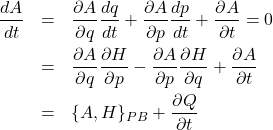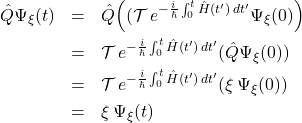What is the time dependence of an expectation value? In the Schrodinger picture
(1) ![Rendered by QuickLaTeX.com \begin{eqnarray*}\frac{d}{dt}\langle \hat{A}\rangle&=&\frac{d}{dt}\langle\psi(t)|\hat{A}(t)|\psi(t)\rangle \nonumber\\ &=&\frac{1}{i \hbar}(\langle\psi|[\hat{A},\hat{H}]|\psi\rangle+\langle\psi|\frac{d\hat{A}}{dt}|\psi\rangle \end{eqnarray*}](http://abadonna.physics.wisc.edu/wp-content/ql-cache/quicklatex.com-98a798248ca8fbace333fba7e1f0fa2e_l3.png)
using ![]() .
.
This formula sees a lot of applications in atomic physics, it is handy for constructing sum rules.
What if ![]() represents a stationary state? Then
represents a stationary state? Then ![]() and
and
![]()
by hermiticity of ![]() :
: ![]() ,
, ![]() for stationary states.
for stationary states.
Note that in general ![]() , you must have
, you must have ![]() for this to be true.
for this to be true.
We will now use the fact that the Hamiltonian is the time evolution operator to prove Ehrenfest’s Theorem. Classically
(2) 
Perform canonical quantization
![]()
and take expectation values
![]()
let ![]() , and use the fact that
, and use the fact that ![]() and the derivation rule for commutators
and the derivation rule for commutators
![]()
Similarly let ![]() , then
, then
![]()
and the proof is complete; expectation values of the position and momentum operators obey the classical equations of motion.
In classical physics conserved quantities have zero time derivative. If dynamical variable ![]() is conserved
is conserved
![]()
Quantum mechanically we see a direct translation through the Correspondence Principle; operator ![]() represents a conserved quantity if
represents a conserved quantity if
![]()
If this is true, then
![]()
by use of our definition of time ordering, and this implies that if
![]()
then
(3) 
and so the same wavefunction is an eigenstate of ![]() with the same eigenvalue at a later time; that eigenvalue was the value of a conserved quantity.
with the same eigenvalue at a later time; that eigenvalue was the value of a conserved quantity.
In the Heisenberg picture the operators carry the time dependence, the wavefunctions do not. A useful observation can be made about how the Heisenberg picture operator acts on wavefunctions.
![]()
can be formally integrated to
![]()
if the Hamiltonian is not explicitly ![]() -dependent, as is the usual case if we are not interacting with external fields. In the Heisenberg picture
-dependent, as is the usual case if we are not interacting with external fields. In the Heisenberg picture
![]()
Suppose that the wavefunction above is an eigenstate of ![]() of eigenvalue
of eigenvalue ![]()
![]()
this can be written as
![]()
or, since ![]() is just a number
is just a number
![]()
The eigenvalue of the Heisenberg picture of the operator at time ![]() is the eigenvalue of the Schrodinger picture of the operator at time
is the eigenvalue of the Schrodinger picture of the operator at time ![]() . This can be used to compute the green function for any system in a very easy way.
. This can be used to compute the green function for any system in a very easy way.
The free particle. Recall that the green function satisfies
![]()
and so ![]() is an eigenfunction of the position operator
is an eigenfunction of the position operator ![]() at time
at time ![]() with eigenvalue
with eigenvalue ![]() . From the above analysis
. From the above analysis ![]() is an eigenfunction of the Heisenberg version of the same operator evaluated at time
is an eigenfunction of the Heisenberg version of the same operator evaluated at time ![]()
![]()
This operator can easily be found from ![]()
(4) ![Rendered by QuickLaTeX.com \begin{eqnarray*}i \hbar \frac{d}{dt}x_H&=&[x_H,\frac{\hat{p}_H^2}{2m}]=-\frac{i \hbar}{m} \, \hat{p}_H \nonumber\\ \mbox{and similarly}\quad i\hbar \frac{d}{dt}\hat{p}_H&=&[\hat{p}_H,\frac{p_H^2}{2m}]=0 \nonumber\\ \mbox{which can be integrated to give}\quad \hat{x}_H(t)&=&\hat{x}_H(0)-\frac{i\hbar t}{m}\frac{d}{dx} \end{eqnarray*}](http://abadonna.physics.wisc.edu/wp-content/ql-cache/quicklatex.com-c70f1b42f67649d74c4ec508c3faee3e_l3.png)
because the second of these formulas implies that
![]()
therefore we have a simple first order equation for the Green function
![]()
![]()